Broadcom Launches Wi-Fi 7 Portfolio for Access Points and Client Devices
by Ganesh T S on April 12, 2022 9:00 AM EST- Posted in
- Networking
- Broadcom
- Wi-Fi
- Access Points
- Wi-Fi 7
- 802.11be

The last few years have seen heightened consumer focus on wireless networking. The industry has also been quite busy, enabling the operation of Wi-Fi 6 (802.11ax) in the 6GHz band with Wi-Fi 6E. In parallel, the 802.11 Working Group had started work on 802.11be with a focus on extremely high throughput (EHT). Wi-Fi 7 is set to become the consumer-facing moniker for 802.11be.
802.11be aims to achieve high throughput primarily through a combination of three aspects:
- Support for up to 16 spatial streams
- Support for channel widths up to 320MHz (with operation in 2.4 GHz, 5 GHz, and 6 GHz bands)
- Support for 4096-QAM (4K-QAM) resulting in better utilization of available spectrum (a faster modulation / coding scheme).
Theoretically, these aspects allow for up to around 46 Gbps of wireless throughput. 802.11be also aims to enable usage of Wi-Fi for real-time applications by including features for low-latency communications such as Multi-link operation (MLO). This allows a client and an access point to simultaneously communicate over multiple channels that might even belong to different bands. Interference and co-existence with non-Wi-Fi users of the same spectrum is handled using automatic frequency coordination (AFC).
A number of additional features targeting these two thrust areas are under consideration for the final standard. However, multiple silicon vendors have already started introducing silicon supporting variations of the aspects included in the first 802.11be draft specifications.
Mediatek was one of the first vendors to demonstrate working 802.11be-compliant silicon earlier this year. Though Mediatek indicated that the products would be marketed under the Filogic lineup, concrete technical details and part numbers were not announced. At MWC 2022, Qualcomm provided details of their 802.11be client silicon targeting mobile devices. The FastConnect 7800 is expected to become available in H2 2022, and integrates Bluetooth 5.3 support with key Wi-Fi 7 features.
Broadcom is announcing a comprehensive portfolio of products targeting various Wi-Fi 7 markets today.
The table below summarize the key features of the products targeting access points. All of these support 4K-QAM and Multi-Link Operation.
| Broadcom 802.11be (Wi-Fi) Access Point Radios Specifications | ||||
| BCM67263 | BCM6726 | BCMN43740 | BCMN43720 | |
| Target Market | Residential Wi-Fi APs | Enterprise Wi-Fi APs | ||
| Operational Band | 6 GHz | 2.4 GHz (or) 5 GHz (or) 6 GHz | ||
| Stream Count | 4 | 2 | ||
| Max. Channel Width | 320 MHz | 160 MHz | 320 MHz | 160 MHz |
| PHY Rate | 11.5 Gbps | 5.75 Gbps | 11.5 Gbps | 2.88 Gbps |
The AP products support AFC in order to ensure that 6GHz range is not affected (the APs are mandated to receive regularly scheduled clearance from a central authority to prevent interference with 6 GHz spectrum users). Broadcom has applied to be an AFC operator and will offer AFC service with their chips. This will use Open AFC code. Broadcom also believes a vibrant Wi-Fi 7 ecosystem requires an AFC service that the device makers can use independent of the chip vendor. Organizations such as the Wi-Fi Alliance, and Wireless Broadband Alliance have applied to be AFC operators, with Open AFC already gaining traction in this.
Tying these together in Broadcom's Wi-Fi 7 router reference design is the BCM4916 network processor. This ARM v8-compatible quad-core SoC includes a dual-issue Runner packet processor (DI-XRDP), an integrated NBASE-T (up to 10G) Ethernet PHY for WAN or LAN, four integrated 1GbE PHYs, three USXGMII interfaces, multiple USB ports, and a 32-bit DDR3/DDR4 DRAM interface.
The quad-core CPU is a custom Broadcom design with 64KB of L1 cache and 1MB of L2 cache, providing up to 24K DMIPS horsepower. Without the knowledge of exact clock speeds, it is difficult to compare against the standard Cortex cores from ARM. Based on the DMIPS number, this appears to slot in-between a Cortex-A53 and an A57, but does not include the ARM v8.2 features of the A55.
Broadcom's customers can play around with the radio configuration in the above design to create products at different price points. Tri-band support becomes compulsory in Wi-Fi 7. The extremely high throughput enabled by this means that 10G support on the WAN/LAN side and NBASE-T support on the LAN front will become the de-facto standard for routers and APs in the coming years.
Broadcom is also introducing the BCM4398 - an integrated Wi-Fi 7 and Bluetooth 5 combo chip targeting smartphones and other mobile applications. It supports two streams of Wi-Fi 7, channel width of up to 320 MHz, and a 6.05 Gbps PHY rate. On the client side, one of the key user-visible updates is low-latency operation. Broadcom claims that the BCM4398 can achieve sub-millisecond latencies for lightly congested environments in the 6 GHz band. The client multi-link operation feature can keep both uplink and downlink latencies between 5 and 10ms in situations where both 5 and 6 GHz bands are highly congested. This provides determinism for AR/VR knowing that worst case latencies will be down to a few milliseconds even during heavy congestion.
Broadcom is the first vendor to announce a complete portfolio of Wi-Fi 7 products, with sampling for key customers already in progress. The new products should give end-consumers a taste of the values delivered by Wi-Fi 7 for different applications a few quarters from now.


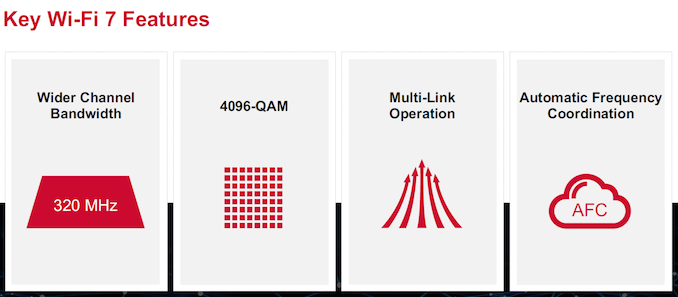
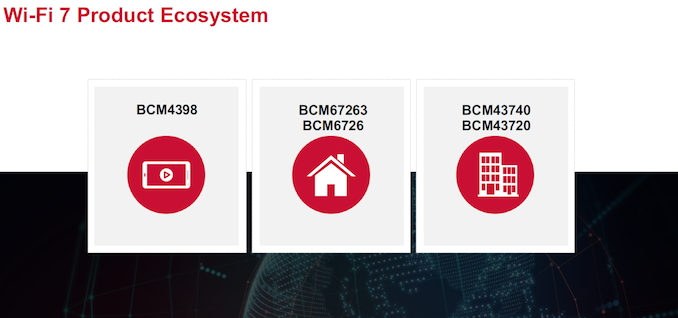
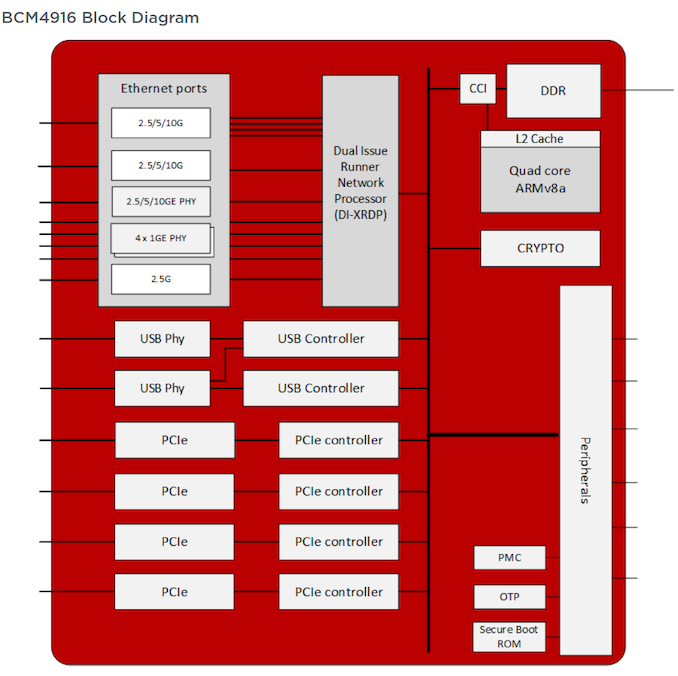
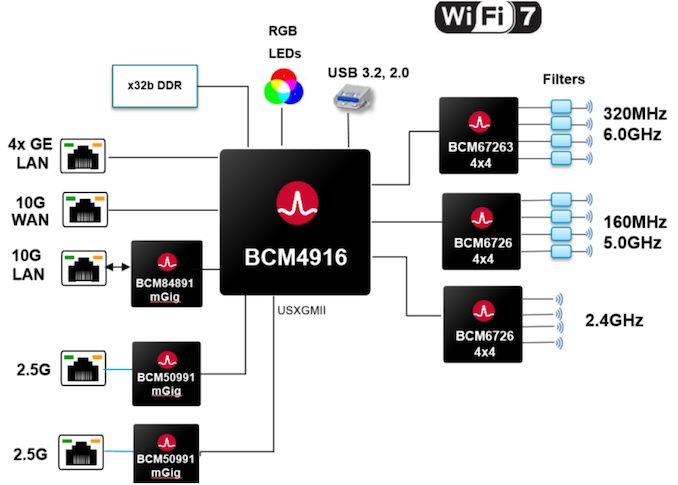
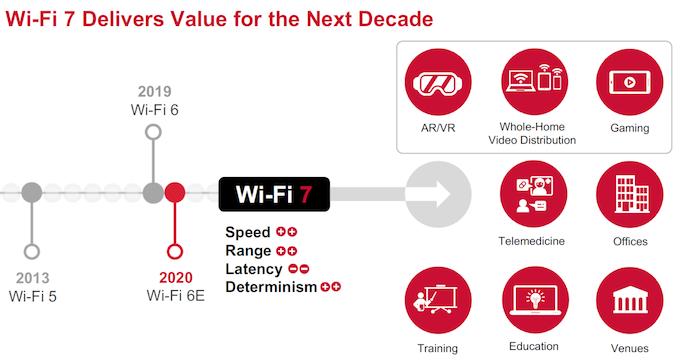














26 Comments
View All Comments
Cryio - Tuesday, April 12, 2022 - link
I have a 1 Gbps connection, up until 2020, I had a 2.4 GHz, WiFi 4, 100 Mbps router.I know have a WiFi 6 phone and a 5 GHz 1.2 Gbps capable WiFi 6 router.
We have 6E and now WiFi 7. I'm personally in no hurry.
DougMcC - Tuesday, April 12, 2022 - link
Certainly a cyclical upgrade. 7 may have better upgrade sales to recent generations (e.g. 6E) because of the feature set, but it will also be the obvious choice to people who are looking to upgrade because they are on older 6, 5, 4 devices. Why buy a 6E once you can buy a 7?heffeque - Wednesday, April 13, 2022 - link
Wifi 6E is totally skippable.Wifi 7 brings quite a slew of new features (not only higher bandwidth) such as aggregating 5 GHz and 6 GHz simultaneously (maybe even 2.4 GHz too), which reduces latency and jitter; and other nice things.
lilkwarrior - Thursday, April 21, 2022 - link
I also have 1 Gigabit Internet: It depends how often you use your Wifi devices and how modern they are. I consume a lot of 4K devices on modern devices with Wifi 6 and 6e support. I also do a lot of remote work doing things like engineering, AI, 3D, and content creation on my M1 Max Laptop, iPad Pro, and iPhone.Accordingly, I could not be in your position to have the privilege to wait. You would not get much ROI from your connection on such slow Wifi.
lilkwarrior - Thursday, April 21, 2022 - link
I have 2 Wifi 6 and 1 Wifi 6E router meshed FWIW.DanNeely - Tuesday, April 12, 2022 - link
"The AP products support AFC in order to ensure that 6GHz range is not affected (the APs are mandated to receive regularly scheduled clearance from a central authority to prevent interference with 6 GHz spectrum users). Broadcom has applied to be an AFC operator and will offer AFC service with their chips. This will use Open AFC code."So I guess this is how the wifi industry intends to solve the problem that even cheap consumer access points are good enough that they only get replaced when they stop working. They'll just turn off this service after N years and cripple all their older routers in the process.
Based on previous Internet of Shit Fuckery I'm guessing something like 5 years after release despite selling the model for at least 3 or maybe 4 years before discontinuing it.
ganeshts - Tuesday, April 12, 2022 - link
That would invite too much consumer backlash.My guess is that APs that don't receive a regularly scheduled clearance would have their transmit power (and thereby, range) reduced for the 6GHz channels - in that way, it would be just like how current Wi-Fi 6E routers operate (and this is a reason why there are no outdoor Wi-Fi 6E APs yet - because range is too low with the allowed power)
DanNeely - Tuesday, April 12, 2022 - link
You mean like how consumer backlash to companies, including some of the largest in the world *cough*Google*cough* killing their existing internet of shit devices by turning off backend services has caused a backlash that stopped people from buying new IoS devices? 🤣🤣🤣cosmotic - Tuesday, April 12, 2022 - link
Is that RGB LED block for status LEDs or like custom color animation flashy glitz?Ninhalem - Tuesday, April 12, 2022 - link
I would suspect that is for the flashier consumer devices, but also for status light rings like in the Ubiquiti AP's. I can quickly look at my AP in my home office and see that the AP is down or reconnecting instead of logging into the management interface. These types of devices also have the option of turning off the LED light sensitive areas.